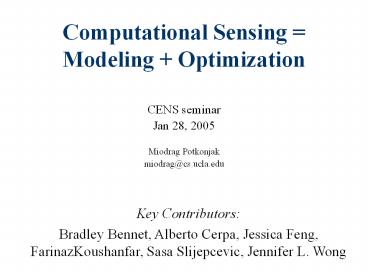Computational Sensing = Modeling Optimization - PowerPoint PPT Presentation
1 / 45
Title:
Computational Sensing = Modeling Optimization
Description:
Bradley Bennet, Alberto Cerpa, Jessica Feng, FarinazKoushanfar, Sasa Slijepcevic, ... CE(xi, yj) = E(xi,yj) mink jE(xi-1,yk) Univariate CIR Approach ... – PowerPoint PPT presentation
Number of Views:66
Avg rating:3.0/5.0
Title: Computational Sensing = Modeling Optimization
1
Computational Sensing Modeling Optimization
- CENS seminar
- Jan 28, 2005
- Miodrag Potkonjak
- miodrag_at_cs.ucla.edu
Key Contributors Bradley Bennet, Alberto Cerpa,
Jessica Feng, FarinazKoushanfar, Sasa
Slijepcevic, Jennifer L. Wong
2
Goals
- Why Modeling?
- Why Non-parametric Statistical Modeling?
- Beyond Non-parametric Statistical Modeling?
- Do We Really Need Models?
- Tricks
- For Fame and Fun
- Applications Calibration
3
Why Modeling No OF, No Results
L1 1.272m L2 5.737m L? 8.365m Gaussian
0.928m Stat. Error Model 1.662x10-3m
Location discovery
4
Why Modeling What to Optimize?
Packet size
5
Why Modeling What to Optimize?
Receiver/Transmitter quality
6
Why ModelingLocalized vs. Centralized
Reception rate predictability
7
Why Modeling Optimization Mechanism
One unknown node
Two unknown nodes
Atomic localization
8
Why Modeling What paradigm to use?
Maximum Likelihood
Distance measurements correlation
9
Why Modeling Protocol Design
Lagged autocorrelation
10
Why Modeling Executive Summary
- Objective Function and Constraints What to
Optimize? - Consistency - Problem Identification Formulation - Variability
- Localized vs. Centralized - Time variability
- Optimization Mechanism - Topology of Solution
space Monotonicity, Convexity - Optimization Paradigm - Correlations
- Design of Protocols - High Impact Features First
11
How to Model?
- Most likely value regression
- Probability of given value of target variable for
predictor variable - Validation
- Evaluation
- Parametric and Non-parametric
- Exploratory and Confirmatory
12
Model Construction Samples of Techniques
- Independent of Distance (ID)
- Normalized Distance (ND)
- Kernel Smoothing (KS)
- Recursive Linear Regression (LR)
- Data Partitioning (DP)
13
Independent of Distance (ID)
14
Normalized Distance (ND)
15
Kernel Smoothing (KS)
16
Recursive Linear Regression (LR)
17
Data Partitioning (DP)
18
Statistical Evaluation of Models
19
Statistical Evaluation of OFs
20
Location DiscoveryExperimental Results
21
Location DiscoveryPerformance Comparison
- ROBUST D. Niculescu and B. Nath. Ad Hoc
Positioning System (APS). GLOBECOM. 2001. - N-HOP A. Savvides, C. Han, M.B. Strivastava.
Dynamic Fine-Grained Localization in Ad-Hoc
Networks of Sensors. MOBICOM. pages 166-179.
2001. - APS C. Savarese, K. Langendoen and J. Rabaey.
Robust Positioning Algorithms for Distributed
Ad-Hoc Wireless Sensor Networks. WSNA. pages
112-121. 2002.
- K. Langendoen and N. Reijers. Distributed
Localization in Wireless Sensor Networks A
Quantitative Comparison. Tech. Rep. PDS-2002-003.
Technical University, Delft. 2002.
22
Combinatorial Isotonic Regression CIR
- Statistical models using combinatorics
- Hidden covariate problem
- Univariate CIR Problem Formulation
- Given data (xi, yi, ?i), i1,,K
- Given an error measure ?p and x1ltx2ltx3ltltxK
- ?p isotonic regression is set (xi, yi), i1,,K,
s.t. - Objective Function Min ?p(xi, yi, ?i)
- Constraint y1lty2lty3ltltyK
23
Univariate CIR Approach
- Histogram ? build error matrix E, eij ?p(xi, yj)
Histogram
Error Matrix
Y
Y
1 2 1 2 5
3 1 4 5 6
2 5 4 9 6
1 6 8 1 2
9 6 3 2 1
46 53 48 34 28
32 37 30 19 18
24 23 20 14 20
20 19 18 27 34
18 27 32 42 52
46
32
24
20
18
20
X
X
24
Univariate CIR Approach
- Histogram ? build error matrix E, eij ?p(xi,
yj) - Build the cumulative error matrix CE
Error Matrix
Cumulative Error
Y
Y
46 73 87 91 99
32 57 69 76 89
24 43 59 71 91
20 39 57 84 118
18 49 81 123 175
46
32
24
20
18
46 53 48 34 28
32 37 30 19 18
24 23 20 14 20
20 19 18 27 34
18 27 32 42 52
X
X
25
Univariate CIR Approach
- Histogram ? build error matrix E, eij ?p(xi,
yj) - Build the cumulative error matrix CE
- Map the problem to a graph combinatorial!
Cumulative Error
Y
46 73 87 91 99
32 57 69 76 89
24 43 59 71 91
20 39 57 84 118
18 49 81 123 175
X
26
Multivariate CIR Approach - ILP
- Given a response variable Y, and two explanatory
X1, X2 ? 3D error matrix E
27
CIR Prediction Error on Temperature Sensors at
Intel Berkeley
- Prediction error over all nodes
28
Combinatorial Regression Flavors
- Minimal and Maximal Slope
- Number of Segments
- Convexity
- Unimodularity
- Locally Monotonic
- Symmetry
- y f(x), x g(y) ? x g(f(x))
- Transitivity
- y f(x), z g(y), z h(x) ? h(x) g(f(x))
29
Combinatorial Regression Symmetry
30
Time Dependant Models
31
Time Dependant Models
32
Do We Really Need Models?
33
Modeling Without Modeling Consistency
x1 lt x2 ? f(x1) lt f(x2) x1 gt x2 ? f(x1) gt
f(x2)
34
On-line Model Construction
35
Statistics for Sensor NetworksExecutive Summary
- Large Scale Time Dependent Modelling
- Hidden Covariates Monotonicity, Convexity, ...
- Go to Discrete and Graph Domains
- Interaction Data Collection - Modeling
- Properties of Networks
- Simulators
36
Tricks Modeling and Sensor Fusion
- Hide Nodes
- Split Nodes
- Weight Nodes
- Additional Dimensions
- Additional Sources
37
Hiding Beacons
38
Splitting Nodes
39
Modeling Networks for Fame Fun
40
Perfect Neighbors
41
Applications
- Calibration
- Location Discovery
- Data Integrity
- Sensor Network Compression
- Sensor Network Management
- Low Power Wireless Ad-hoc Network Lossy Links
42
Calibration
- Minimal Maximal Error
- Minimal Average Error median
- Minimal L2 Error average
- Most Likely Value
Error
L?
ML
43
Calibration Model for Light
44
Interval of Confidence
45
Summary Recipe for SN Research
- Collect Data
- Model Data
- Understand Data
- ...































